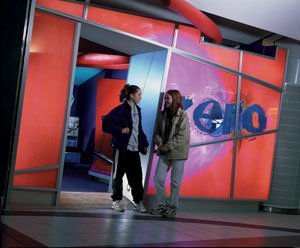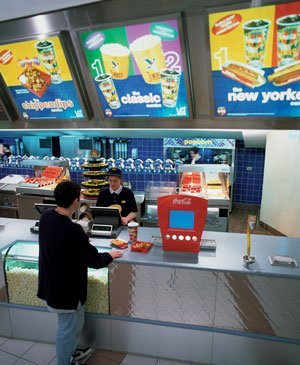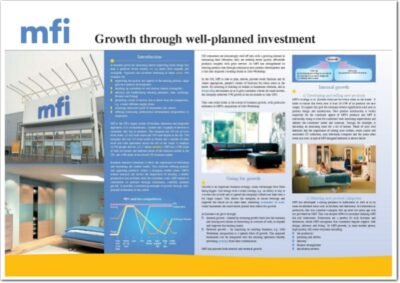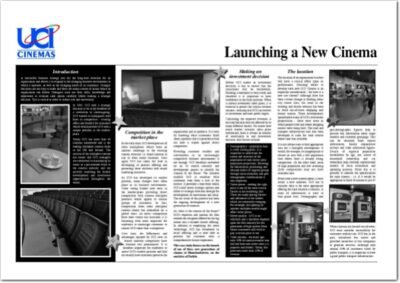
A successful business strategy sets out the long-term direction for an organisation and allows it to respond to the changing business environment in which it operates, as well as the changing needs of its customers. Strategic decisions are not easy to make and there are many courses of action which an organisation can follow. Managers must use their skills, knowledge and experience to evaluate each option carefully before making a strategic decision. This is critical in order to reduce risk and uncertainty.
In 1985, UCI took a strategic decision to be at the forefront of a revolution in cinema-going. UCI wanted to distinguish itself from its competitors – creating offers and benefits for customers which would provide UCI with a unique position in the marketplace.
Today, UCI has more than 30 cinemas nationwide and is the leading multiplex cinema chain in the UK and Ireland. The success of the multiplex concept has meant that UCI managers are committed to maintaining its status as a pre-eminent force in the cinema industry and are actively searching for further development and investment opportunities throughout the world.
Competition in the market-place

In the early days, UCI developed out of town multiplexes which were an indirect challenge to the existing cinema structure i.e. dated cinemas in city or town centre locations. Once again UCI has taken the lead in developing its product offering and promoting these attributes with sound marketing initiatives. As UCI has developed its market position, many changes have taken place in its business environment. Other strong brands now exist in the market-place providing direct competition with cinema multiplex products which appeal to similar groups of customers. In fact, competition from other multiplex cinema chains has intensified on a global basis. As direct competition from other chains has increased, it is becoming even more important for marketers to encourage customers to choose UCI rather than a competitor.
Over time, the differences and advantages enjoyed by UCI over its leisure industry competitors have become less pronounced. It is therefore important for marketers to assess UCI’s market position and find out exactly how customers perceive the organisation and its products. It is only by knowing what customers think about a product that it is possible to find out how it stands against direct competitors. Providing customer comfort and convenience in an increasingly competitive business environment is not enough. UCI therefore embarked on an 18 month research and development project to identify the ‘cinema of the future’. The research enabled UCI to examine what customers want from a visit to the movies. It provided a base from which UCI could assess strategic options and refine its strategic direction through the development of innovations and ideas. The net result of this process has been the ongoing development of a new generation of cinemas.
So, what is the cinema of the future? UCI’s expertise and passion for film extends the escapism offered by the big screen into a broader leisure offering. In addition to employing the latest technology, UCI has broadened its retail offering and is now able to provide the customer with a comprehensive leisure experience.
This case study focuses on the launch of one of these new generations of cinema at Blanchardstown, on the outskirts of Dublin.
Making an investment decision

Before UCI makes an investment decision, it has to ensure that the investment will be worthwhile. Building a multiplex is very costly and therefore it is important to have confidence in the final outcome. When a cinema investment takes place, it is essential to predict the various revenue streams – ensuring that UCI can recover its investment and meet profit targets.
Calculating the expected revenues is not easy because they are affected by so many different factors. No matter how much market research takes place beforehand, there is always an element of uncertainty in any investment decision. Key factors include:
- Demographics – population data is a key starting point. It is important to understand the nature and structure of the population of each district plus population projections. Knowing the behavioural, purchasing and lifestyle habits of targeted groups through socio-economic and geo-demographic classifications is also important.
- Ticket prices – seeking the right price is one of the most critical factors in the marketing mix. There are many pricing factors and influences in the market which are constantly changing. For example, the opening of another multiplex nearby might affect ticket prices.
- Movie quality – UCI is an exhibitor and it therefore depends upon the film industry for the generation of high quality films which consumers will wish to pay a certain price to see.
- Other income – ten years ago, only 10% of cinema revenue was derived from non-ticket sales (i.e. popcorn and drinks). Today, this generates more than 25% of revenue.
The location
The location of an organisation’s outlets will have a critical effect upon its performance. Deciding where to develop each new UCI Cinema is an important consideration – but how is a new site chosen? Although there has been a recent change in thinking about city centre sites, the trend in the retailing and leisure industry has been to build out-of-town shopping and leisure centres. These developments spearheaded many of UCI’s investment propositions – these were areas in which people lived and where shopping centres were being built. The road and transport infrastructure had also been developed to cater for such centres where land was available.
It is not always easy to find appropriate sites for a multiplex development. It would, for example, be inappropriate to choose an area with a low population base where there is already strong competition. On the other hand, areas of high population and low screening (little competition) may not have available land.
Every time a new cinema opens, it must attract a new audience. UCI has to consider what is the most appropriate offering for each location it chooses. A mass of information is used to find prime sites. Demographic and geo-demographic figures help to provide key information about target markets and customer groupings. This can be obtained from census information, family expenditure surveys and trade association figures. Details of regional population breakdowns by age, sex, nature of household ownership and car ownership help develop sophisticated models of local economies and spending patterns. From this it is possible to identify the specifications for each cinema – i.e. if it would be appropriate to build 20 screens or just 6?
When cinemas are located out-of-town, UCI must consider accessibility for customers without cars. UCI has, in the past, subsidised bus routes and provided incentives to bus companies to generate services. Although only around 10% of customers travel by public transport, it is important to have a good public transport infrastructure.
At the end of 1996, UCI opened its third cinema in Dublin – a ‘new generation’ cinema at Blanchardstown. This is a new shopping centre of around three quarters of a million square feet on the outskirts of Dublin. It serves Dublin’s growing north-west sector where 5,000 homes are being constructed in a large housing development. After completing indepth research, UCI decided to open up a 9-screen cinema.
The new generation of cinemas

This concept was designed to extend the escapism offered by the big screen into a broader leisure offering. One of the aims of the new leisure developments is to find better ways of offering more to the customer in return for a higher customer spend. For example, the new generation of cinemas have bars, cafés, children’s party rooms and retail areas providing the customer with pre and post show relaxation time in which they can browse and enjoy the offers. By doing this, UCI hopes to enhance the customer ‘experience’ – developing their loyalty and providing points of differentiation over UCI’s competitors. UCI wants to offer its customers better service and promotions and something which is different and exclusive to UCI. UCI’s leisure experience includes the following:
- Open entrances – often from a shopping mall, with the latest ticketing technology.
- Multi screens – with stadium seating comprising high-backed seats and extended leg room.
- Concessions – UCI has extended the drinks and popcorn offering to include nachos, hot dogs, pick ‘n’ mix sweets and children’s Film Feast.
- Non-food merchandising – UCI has licenses to sell a wide range of film related merchandise, providing customers with the opportunity to purchase mementoes.
- Cafe concept – UCI has developed a cafe concept selling a range of alcoholic and non-alcoholic beverages and complimentary food items appealing to a broad cross-section of customers.
- Party rooms – the UCI party rooms are designed to offer children of all ages (target age 5- 11) the opportunity to celebrate their birthday parties in style, either before or after seeing a film of their choice. The rooms are brightly coloured with state of the art lighting, built-in games and video screens to play the latest pop videos or the children’s favourite cartoons.
- Comprehensive programme for younger customers which is headed up by two cartoon characters; ‘UC’ and ‘I’. The programme includes a Film Feast, birthday parties, ‘UC’ and ‘I’ costume characters and a ‘UC’ and ‘I’ comic which is produced quarterly.
- Zero – offers the latest interactive game technology, including motion ride technology, into the cinema environment to provide a sensory experience.
The launch
Before the cinema construction was finished, the planning for the launch was well underway. The starting point was to set the objectives for launch activities. A launch should make customers aware of the new product and make them want to find out more. A key element for UCI was to develop a customer-based strategy which would create a high level of awareness – generating interest and creating a desire by customers to try it out. The mnemonic often used by marketers to describe this approach is AIDA:
- A – A customer’s attention is captured and he or she is made aware of the product.
- I – The impact of the promotion stimulates the customer’s interest.
- D – The customer thinks that they are deprived because they have not tried the product, and this stimulates a desire to use it.
- A – Action involves trying the product out.

Action words are a good way of making the customer think about doing something. UCI used ‘The Great Escape’ tagline teaser to initiate the campaign at Blanchardstown. The idea was that customers would feel that the cinema could provide escapism from their humdrum day-to-day activities.
The theme translated across a variety of activities including radio commercials and bus advertising. Marketers often talk about ‘above the- line’ and ‘below-the-line’ activities. Above-the-line activities refer to media such as the press, TV and radio for which commission is paid to an advertising agency. The launch at Blanchardstown crossed from above the – line advertising, including radio commercials, into below-the-line advertising in which fee-based promotional techniques were directly marketed at target grouped groups of customers. These included:
- the use of direct marketing – sending leaflets and mail-shots within identified areas
- using fake wheel clamps together with spoof parking tickets placed on selected cars in streets and car parks as an amusing way of creating exposure and encouraging people to talk about the new UCI
- creating Hollywood celebrity lookalikes to visits pubs and cafes in Dublin to show that something exciting was happening within the City.
The opening weekend
The opening night is a vitally important starting point for any new location. At Blanchardstown, it was important to use the opening night as a public relations exercise to build a positive image and generate a receptive external environment. A mobile rig helped to gather in the crowds. Celebrities were invited together with journalists and TV stations and Patsie Kensit opened the cinema.
More than 80,000 customers visited the cinema during the first few days. Children’s party rooms were fully booked. 2,200 tubs of popcorn were sold as well as 3,000 soft drinks, 450 coffees and 300 gifts and souvenirs. The launch was a success. It was now critical to evaluate whether this new concept would stand the test of time.
Conclusion

The new multiplex at Blanchardstown is not designed to target a single audience. With nine screens, it takes a variety of market segments into account, such as young children on Saturday mornings, teenagers later in the day and adults wishing to combine an evening out with a cinema experience. The success of Blanchardstown will depend upon how an audience is built over a longer period. Promotions are particularly good at doing this. UCI has used three different sorts of promotions designed to build loyalty and develop usage. These are:
- traffic promotions using a media partner designed to encourage customers to use the cinema
- reward promotions which add value to a visit to a UCI
- retail promotions with concessions, such as the Lost World promotion.
The key to the long-term future of UCI is to keep feeding the entertainment needs of the market with high quality film products. It is only with the support of the film industry that this concept can grow. As with Blanchardstown, each successful opening needs to be built upon. The new generation of UCI Cinemas is more than a building full of cinema auditoriums. The aim has been to build upon the multiplex concept in a way which further differentiates UCI from its rivals so that more people will not only go to the cinema more often, but when they go, they will choose UCI in preference to any other brand.
 Continuous improvement within an organisation (MP3)
Continuous improvement within an organisation (MP3)  Building brand equity (PDF)
Building brand equity (PDF)  Creating a new transport system (PDF)
Creating a new transport system (PDF)  Growth through well-planned investment (PDF)
Growth through well-planned investment (PDF)  Syngenta A3 ePoster Edition 16 "Investment appraisal in action"
Syngenta A3 ePoster Edition 16 "Investment appraisal in action"  The People Collection Business Case Studies eBook
The People Collection Business Case Studies eBook  Vodafone A3 ePoster Edition 13 "Stakeholders in recycling and re-use at Vodafone"
Vodafone A3 ePoster Edition 13 "Stakeholders in recycling and re-use at Vodafone"  Launching a new cinema (PDF)
Launching a new cinema (PDF) 